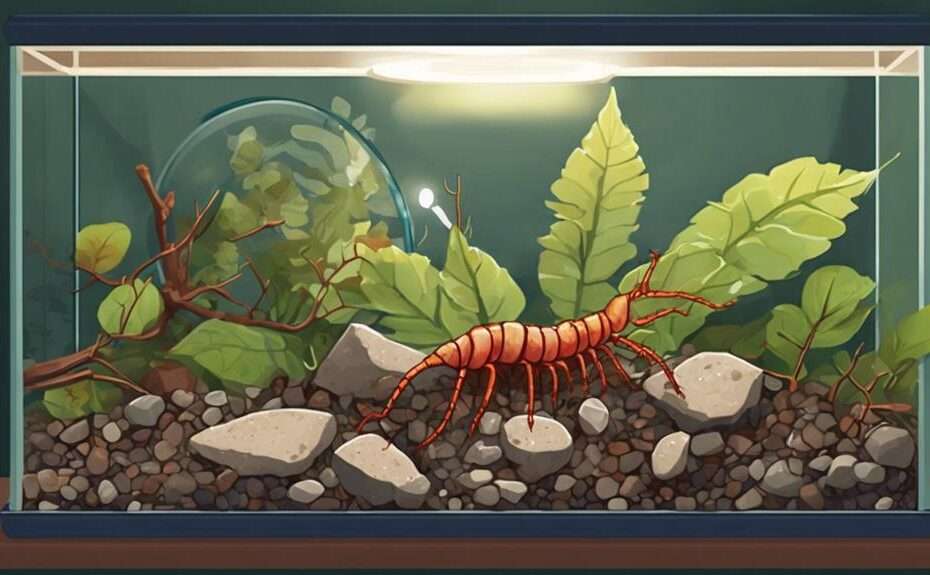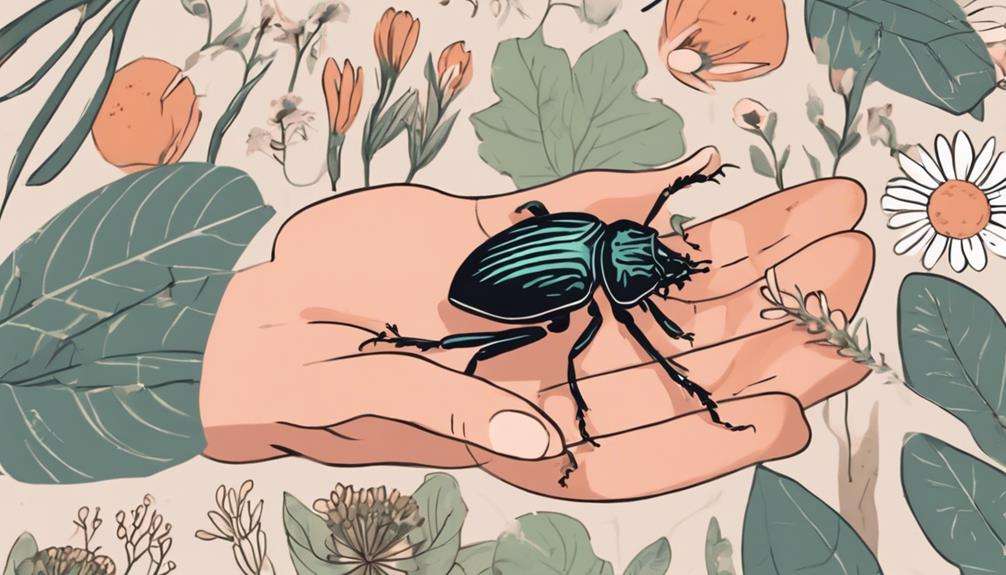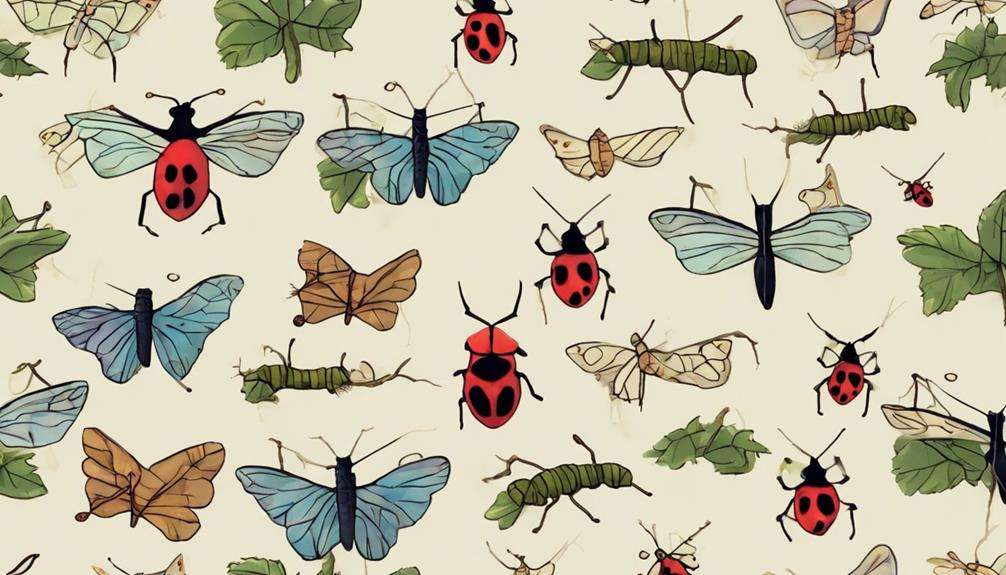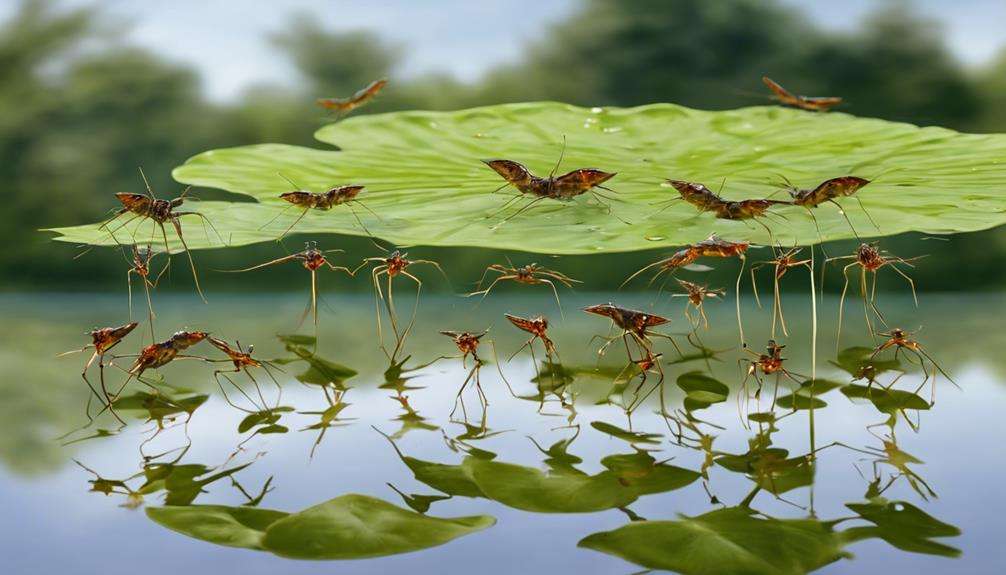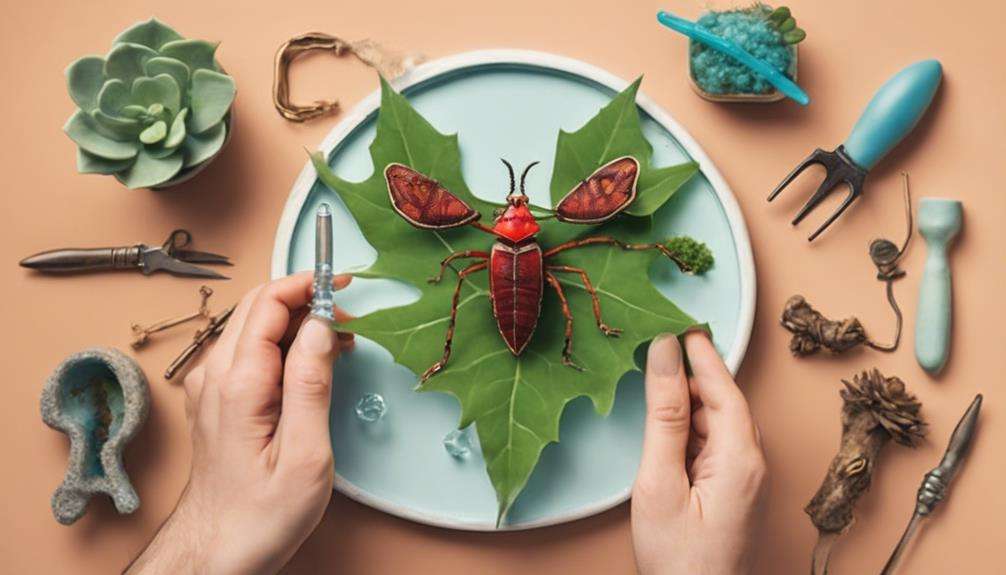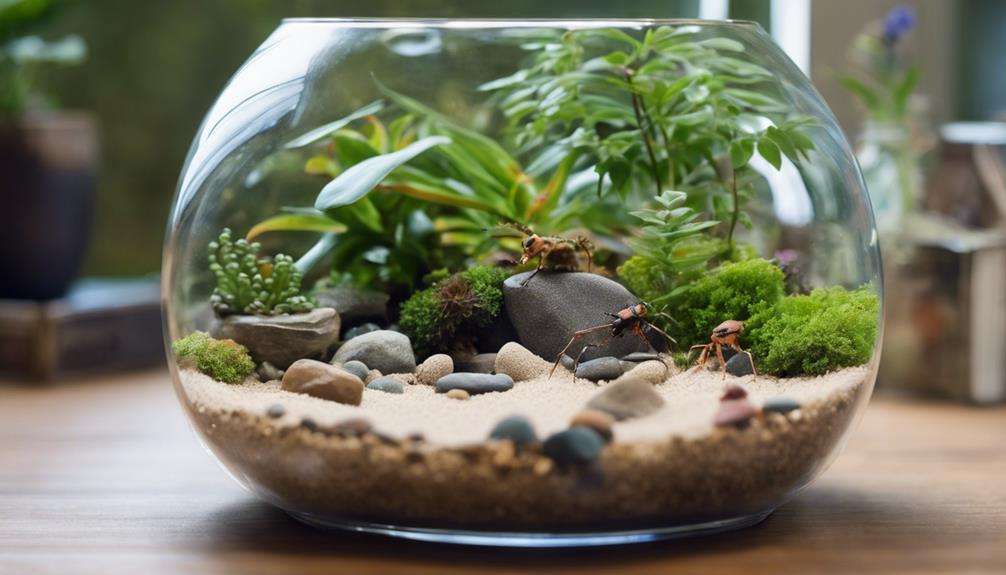When caring for pet centipedes, creating a suitable habitat, feeding them properly, and ensuring hydration are essential steps.
But what about handling and safety tips, monitoring their health, understanding their lifecycle, and addressing common health issues?
These aspects play important roles in providing excellent care for your pet centipedes.
Stay tuned to uncover these essential strategies that will help you build a strong bond with your fascinating arthropod companions.
Key Takeaways
- Maintain high temperatures and humidity levels for habitat
- Feed live prey twice daily with varied options
- Monitor health closely for signs of dehydration or illness
- Handle centipedes with care using proper tools and precautions
Suitable Habitat for Pet Centipedes
To create an ideal living environment for your pet centipede, maintain a habitat with temperatures above 80 degrees Fahrenheit and humidity levels ranging between 75% to 85%. Centipedes are highly sensitive to their environment, so ensuring these conditions are met is important for their well-being. Humidity levels play an important role in centipede care as they help in maintaining the centipede's respiratory functions and hydration. Inadequate humidity can lead to dehydration and respiratory issues in pet centipedes.
To meet the habitat requirements of your pet centipede, consider using a substrate that retains moisture well, such as coconut fiber or peat moss. These substrates aid in maintaining the necessary humidity levels within the enclosure. Additionally, providing a shallow water dish can help increase humidity through evaporation, ensuring your centipede has access to sufficient moisture. Proper ventilation is also essential to prevent the buildup of stagnant air and mold growth, which can be harmful to your pet centipede.
Proper Feeding for Pet Centipedes
Maintain a feeding schedule that includes live prey twice a day to meet the natural hunting instincts of your pet centipede. To provide a balanced diet, offer a variety of prey such as crickets, roaches, earthworms, and small spiders.
It's important to adjust the size of the prey accordingly, make sure they're no larger than half the centipede's size to prevent choking or injury during feeding. Removing any uneaten food promptly is essential to prevent mold growth and maintain a clean habitat for your pet.
Additionally, consider supplementing your centipede's diet with reptile vitamin/mineral powder to make sure they receive all necessary nutrients. Observing these feeding habits will help keep your pet centipede healthy and satisfied in their captive environment.
Hydration Needs of Pet Centipedes

Ensuring proper hydration is essential for the health and well-being of your pet centipede, especially since they primarily obtain water from the prey they consume. While centipedes can derive most of their hydration from the insects they eat, it's still important to provide a source of water in their enclosure. Consider offering a shallow water dish with fresh water, ensuring it isn't too deep to prevent accidental drowning. Additionally, maintaining adequate humidity levels by misting the enclosure regularly can help meet your centipede's hydration needs.
When creating the ideal habitat for your pet centipede, the depth of the substrate and the presence of leaf litter can also play a role in supporting their hydration requirements. A substrate that retains moisture without becoming waterlogged is beneficial. Including leaf litter can create microenvironments that help regulate humidity levels within the enclosure, aiding in keeping your centipede hydrated.
Handling and Safety Tips
When handling your pet centipede, always employ padded forceps or tongs as a safety measure against potential bites. Centipede bites can be painful and may cause swelling due to their venomous bite. It's important to wear gloves if necessary to prevent direct contact with the centipede's venomous fangs.
Exercise caution and gentleness when relocating your centipede to avoid causing stress or injuries to the creature. Direct handling of centipedes with bare hands should be avoided to minimize the risk of bites. When catching and transferring your centipede, securely place it in a tub with a tight-fitting lid for safety purposes.
Monitoring Health of Centipedes
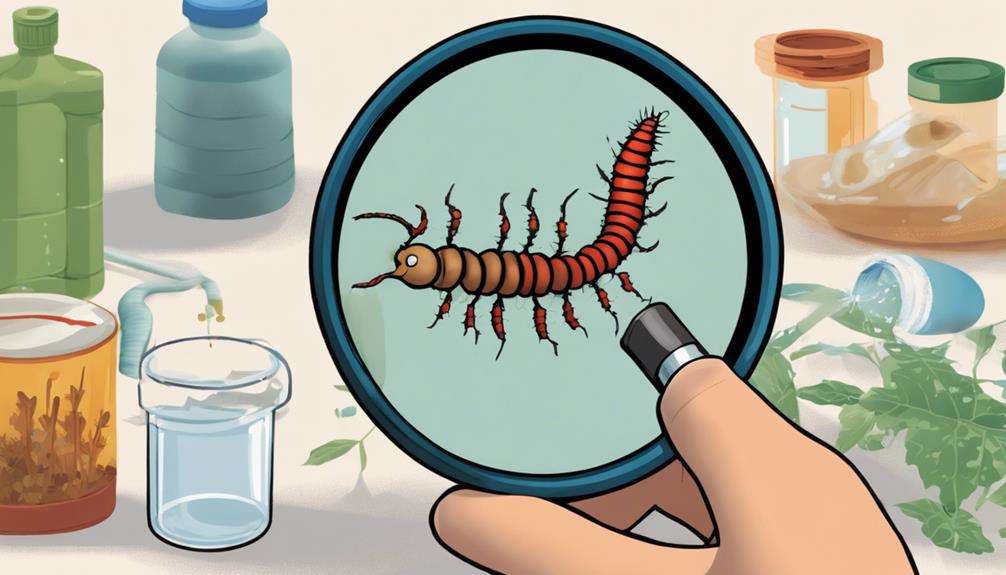
Monitoring the health of pet centipedes involves observing their eating habits, behavior changes, signs of dehydration, physical abnormalities, and seeking veterinary care for persistent illness or distress. To guarantee your centipede's well-being, keep a close eye on its feeding routine. Centipedes are carnivorous and should consume prey regularly to maintain their health. Any deviation from this behavior could be a sign of an underlying health issue.
Additionally, watch out for changes in behavior such as lethargy or increased aggression, as these could point to health concerns.
Dehydration is a common issue in centipedes, so it's important to check for symptoms like curled segments or sluggish movements. If you notice any signs of dehydration, provide a water source for your centipede to prevent further complications. Physical abnormalities such as discoloration, lesions, or missing segments should also be carefully monitored, as they may indicate health problems.
Creating Enrichment for Centipedes
To enhance the well-being and engagement of your pet centipede, consider providing a range of enrichment opportunities that cater to its natural behaviors and instincts. Centipedes thrive in environments that offer stimulation and mimic their natural habitat.
Start by incorporating various hiding spots and structures for exploration to stimulate their innate behaviors. Live prey can serve as enrichment, allowing your centipede to hunt and feed as it would in the wild, promoting its natural predatory instincts. Additionally, offering different textures and substrates for burrowing and digging activities can keep your centipede engaged and content.
Introduce safe objects like rocks, branches, or leaves for climbing and perching to encourage movement and exercise, which are essential for their well-being. Monitoring your centipede's response to these enrichment activities is essential; adjust based on its preferences to ensure a stimulating environment that supports its physical and mental health.
Reproduction and Lifecycle of Centipedes
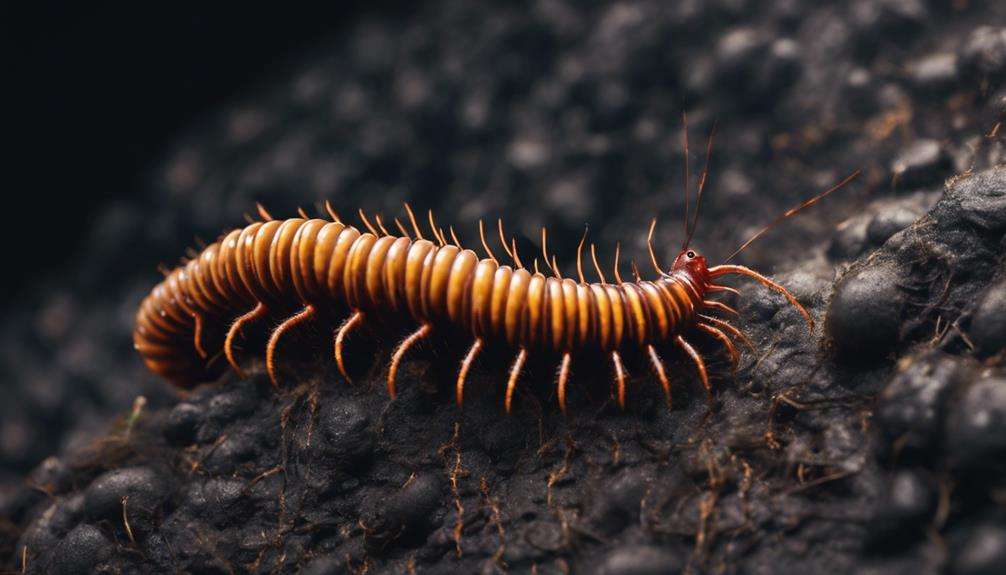
Reproduction in centipedes involves a sexual process, with males depositing sperm packets for females to pick up. After fertilization, females lay their eggs in soil or crevices, where some species guard them until hatching. Centipede eggs hatch into miniature versions of adults and go through multiple molts to reach maturity. The centipede's lifecycle progresses through egg, larval, nymph, and adult stages. Lifespans of centipedes vary among species, with some living for several years.
Understanding the reproduction and lifecycle of centipedes is important for their care. Providing suitable conditions that mimic their natural habitat can support successful reproduction and development. Monitoring the eggs and young centipedes is vital to guarantee their well-being during vulnerable stages. By recognizing the different life stages and lifespans of centipedes, you can better appreciate their growth and behavior as pets.
Common Behavioral Patterns in Centipedes
Centipedes, being nocturnal creatures, exhibit common behavioral patterns that include solitary living, predatory hunting, and territorial defense. These giant centipedes are voracious predators, preying on insects and spiders with great agility and speed. Their solitary nature means they prefer to hunt and live alone, avoiding interactions with other centipedes except during mating.
Centipedes are known for their excellent hunting skills, using their venomous bite to immobilize prey or ward off potential threats. When it comes to territorial defense, some centipedes display aggression towards intruders, marking and defending their space fiercely. Additionally, centipedes are escape artists, utilizing their agility and speed to flee from danger or difficult situations.
Understanding these common behavioral patterns in centipedes is essential for providing them with a suitable living environment in captivity and ensuring their well-being as pets.
Addressing Common Health Issues
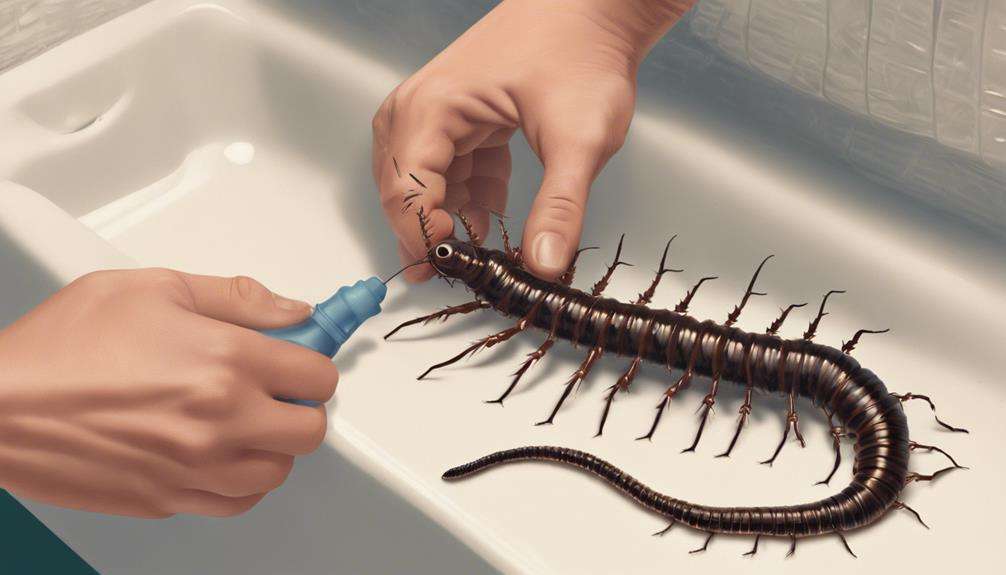
As you observe your pet centipede, vigilant monitoring for signs of dehydration, molting issues, unusual behavior, infections, and parasitic infestations is important for maintaining its overall health and well-being. Hydration can manifest as lethargy or sunken eyes, so make sure a shallow water dish is available for hydration. Molting issues, such as incomplete molts or difficulty shedding, may indicate improper humidity levels. Adjust the humidity in the enclosure accordingly to assist in the molting process.
Unusual behavior like excessive hiding or loss of appetite should prompt a review of environmental conditions and consideration of veterinary advice if necessary.
Infections, characterized by redness, swelling, or discharge, require immediate attention from a veterinarian for proper diagnosis and treatment. To prevent parasitic infestations, maintain a clean habitat, promptly remove uneaten prey, and choose suitable substrate to minimize risks.
Interacting With Your Pet Centipede
Interaction with your pet centipede should be primarily conducted during the evening or night, as they're primarily nocturnal creatures. When handling your centipede, always use tongs or forceps to prevent getting bitten by its venomous mandibles. Centipedes can become stressed if excessively handled, so it's best to limit interaction to essential care routines.
By providing live prey for your centipede, you can stimulate its significant hunting instincts and make sure it receives adequate nutrition.
Observing your centipede's behavior is vital to understanding its well-being. Look for signs of activity, stress, or illness, and address any concerns promptly. Monitoring your centipede regularly can help you identify changes in its behavior, appetite, or movement patterns.
Frequently Asked Questions
How Do You Take Care of a Pet Centipede?
To care for a pet centipede, guarantee secure housing with hiding spots. Maintain humidity at 75%-85%. Feed live prey twice daily adjusting size to centipede. Avoid direct handling to prevent bites. Monitor behavior and health regularly.
Can Centipedes Be Kept as Pets?
Yes, centipedes can be kept as pets. Their fascinating behavior, predatory feeding habits, and specific enclosure setup requirements make them unique additions to your home. Research their needs thoroughly to guarantee a safe and enriching environment.
What Is the Lifespan of a Pet Centipede?
In caring for a pet centipede, consider its lifespan influenced by feeding habits, environmental conditions, and reproduction cycle. Guarantee proper diet, habitat setup, and monitoring to promote longevity. Create a suitable home environment for best health.
Can You Handle Pet Centipedes?
You should avoid handling pet centipedes due to their aggressive nature and venomous bites. Utilize padded forceps or a secure container for relocation. Understanding their behavioral traits, feeding habits, and implementing proper handling techniques is essential for safety.
Conclusion
To sum up, by following the 10 best ways to care for pet centipedes, you can guarantee a fulfilling and enriching experience with these fascinating creatures.
Remember to provide a suitable habitat, offer proper nutrition, and handle them with caution.
Monitoring their health and behavior, as well as addressing any potential issues promptly, will contribute to the well-being of your pet centipede.
Embrace the unique challenges and joys of caring for these remarkable arthropods.
